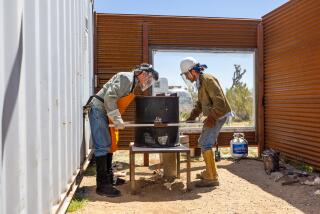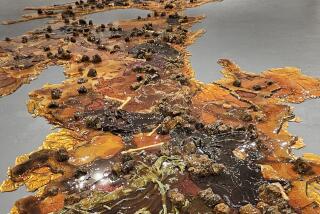A spiritual ‘Peace’ of mind
TENZIN GYATSO, the 14th Dalai Lama of Tibet, has met with world leaders and pop culture icons. He has been the subject of books and movies. And now he is the focal point of the traveling group exhibition “The Missing Peace: Artists Consider the Dalai Lama,” premiering at the UCLA Fowler Museum.
The exhibition, co-sponsored by Tibetan support groups the Dalai Lama Foundation and the Committee of 100 for Tibet, includes film, photography, sculpture and video works by contemporary artists from 25 countries.
Curator Randy Rosenberg said “The Missing Peace” isn’t an attempt to visually characterize the Dalai Lama, nor is it meant to be a political exhibition. Rather, she said, it’s an intersection of the Dalai Lama’s message and the artists’ personal expression reflecting upon core Tibetan Buddhist values.
More than 80 artists, including Bill Viola, Enrique Martinez Celaya, Anish Kapoor and Richard Avedon, have contributed new and old works. In choosing the artists, Rosenberg found those who “deal with certain themes in their artwork, whether it was in a more abstract, spiritual or Buddhist-oriented way.”
The show is organized among 10 points -- among them “peace,” “empathy and compassion,” “globalization” and “impermanence.” It was also given the thumbs up by the Dalai Lama.
“He was very specific about the show,” Rosenberg said. “He was interested to know if there were Chinese artists. He wanted to know if the work would be traveling to countries where peace is important and encouraged us to find venues in parts of the Middle East and Africa. And he really zeroed in on key environmental issues.”
Given the artists’ many backgrounds, the approaches are diverse. Some of the artists met with the Dalai Lama during the show’s conception, including video artist Viola. He describes the meeting as “one of the high points of my life. He’s probably one of the clearest human beings I’ve ever been in the presence of.”
When Viola met with him in December, he watched the religious leader give a teaching to Tibetan refugees and say a special public prayer, followed by a private audience with him.
“He has a completely focused mind, which is one of the most important goals of Buddhist training -- to clarify the mind with living awareness and focus in the present and not the past or future,” Viola said.
Viola has two presentations for the show. The first is “His Holiness XIV Dalai Lama: A Blessing,” a prayer by the Dalai Lama that greets the visitor at the foot of the gallery’s entrance.
“It’s like a high-tech prayer wheel. It’s sending out a blessing in a fully potent form,” Viola said.
His second, main video piece comprises two plasma screens that show illuminated male and female bodies whose internal structures are revealed until only black silhouettes remain.
The work is “personally meaningful” for Viola, who has studied Zen Buddhism for more than 20 years. “It’s a very important occasion. It’s a wonderful thing that artists are responding directly to such an important tradition as Tibetan Buddhism.”
For artist Enrique Martinez Celaya, “the idea of Zen Buddhism and the idea of the Dalai Lama in particular happens to be very influential in my work. Being commissioned to do a piece for the exhibition on the Dalai Lama, whose message and presence I respect very much, became a very moving and challenging request.”
His “No Title” painting is a large two-paneled work, with one side depicting an electrical storm painted with blood and charcoal and the other side a mirror. The work, Martinez Celaya said, was a way of exploring the idea of compassion and was an emotionally exhausting piece that took 2 1/2 months to complete.
The interactive work “The Golden Thread,” by San Francisco artist Kirsten Bahrs Janssen, invites visitors to pull on a piece of golden thread from 15 spools that “spiritually links” each person who participates in the work.
The opportunity to contribute to “The Missing Peace” resonated with her as an artist whose works explore the idea of her own existence.
“People need an icon for kindness, and I look to the Dalai Lama as that spirit. I think art can interact in a compassionate way and have some interconnectedness,” Bahrs Janssen said. “I’m not Buddhist and I’m not very versed in his works, but I know of his integrity. The work I created had to envelope his spirit and compassion.”
Louis Fox and his Bay Area company Free Range Graphics created a silent animated short illustrating the idea that compassion is a fundamental component in each individual.
“He’s always trying to spread the idea of compassion as a way of life. I approached the work as a public service announcement for that message,” Fox said.
After exhibiting at the Fowler, “The Missing Peace” will go to Chicago and New York. There are plans to tour internationally, with institutions from Croatia, Taiwan and Italy expressing interest.
Rosenberg stresses that the show isn’t about hero worship but about offering a message that anyone, regardless of their beliefs, can take to heart.
“The Dalai Lama’s an icon for peace, and there aren’t a lot of individual symbols in the world like that,” Rosenberg said. “His messages are so much bigger than just Tibet. It’s really about freedom and peace for all people.”
*
‘The Missing Peace’
‘Artists Consider the Dalai Lama’
Where: UCLA Fowler Museum of Cultural History, Sunset Boulevard and Westwood Plaza, Westwood
When: Noon to 5 p.m. Wednesdays through Sundays, except noon to 8 p.m. Thursdays
Ends: Sept. 10
Price: Free
Info: (310) 825-4361, www.fowler.ucla.edu
More to Read
The biggest entertainment stories
Get our big stories about Hollywood, film, television, music, arts, culture and more right in your inbox as soon as they publish.
You may occasionally receive promotional content from the Los Angeles Times.










